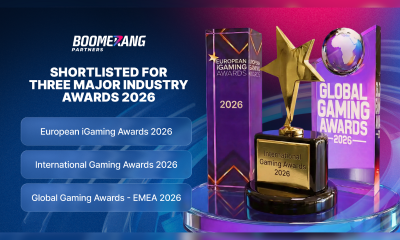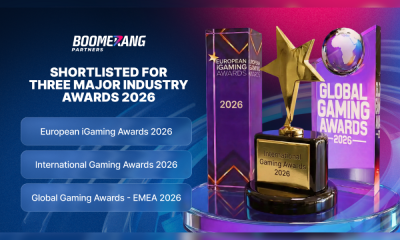Central Europe
The Right RTP for the German 5.3% Turnover-taxation?
So, you may have seen a poll I have published recently with the title: “If/when Germany introduces the 5.3% turnover tax, what RTP rate is best suited considering both game-play and effective tax-paid?” If you haven’t seen it, here is the poll again for reference:
https://www.linkedin.com/feed/update/urn:li:activity:6790660730564825088/
There are a few ways of looking at this, but I think the key take-away is that the industry this poll represents is fairly evenly split between above 90% RTP and below 90% RTP.
The tax explained
First, to ensure we are on the same page, a quick explanation of the tax proposed:
Currently a 5.3% tax on turnover has been proposed and a draft-legislation does exist. I won’t go into the politics and the thinking behind this, but rather try to analyze the numbers.
A 5.3% tax on every bet being placed on an online slot means an operator can not offer an RTP over 94.7%. At 94.7% RTP, the operator would break even exactly on a bet-level, but obviously would lose money as marketing, employees and general operation have to be financed somehow. Considering financial overhead in any operation, that means the maximum RTP a casino is technically able to offer while avoiding bankruptcy is probably around 93% or more likely at 92%. This is the top ceiling and at the same time too high to be profitable.
Now, there is a bit of uncertainty and I’m also not entirely sure if the number to calculate against is 5.3% or rather 5.033%. The tax is 5.3% on turnover, meaning a 1 EUR bet causes a tax of 5.3 cents, which totals to 1.053 EUR. The tax-portion of 1.053 EUR is less than 5.3%. 100*5.3/(100+5.3) = 5.033 resp. 5.033%. I do calculations here in this document based on 5.3%.
How to balance RTP and profitability
We’ve established above that 93% or 92% is the top ceiling, but where is the bottom?
The table below shows how a Slots-operator will be taxed, calculated into the GGR-equivalent %-age number and cross-referenced with RTP. For reference, many other jurisdictions in Europe offer a GGR-based tax-rate of around 20%. As you can see from the table below, the 5.3% tax-rate on turnover wouldn’t be so bad, if players would accept 80% RTP. At 80% RTP, the GGR-equivalent tax-rate is 26.50% and thus a competitive tax-rate.
The coloring I have done here may be slightly biased, especially in terms of RTP so please take with a grain of salt. But if you roughly accept that the red-area you want to avoid on the RTP and on the GGR-% side, then you end up with an RTP-bandwidth between 84% and 91% to play with.
Further, and again granted you accept the coloring, an operator obviously wants to find an RTP in the green and a GGR-% in the green. Here we arrive at 88% and 89% RTP.
Now, a lot has been written that players will not accept such low RTP’s as say 84%. There are counter-arguments made that in land-based slots the RTP is exactly at that level and actually 88% is on the higher-end in land-based casinos.
On the other hand, for many market-participants the number “9” is a psychological blocker. Players, Affiliates and a couple of Slots-Studios I speak to feel very anxious offering product below 90% as this number still feels somewhat close to the industry-average of 94 to 97%. 89% sounds very different than 90%, although it is “just” 1% in RTP dropped.
Sportsbook vs. Casinos
It will be interesting to watch if Sportsbook or Sports-led brands will choose a differing RTP-rate than Pure-Play Casinos. A Sportsbook can more easily stay on a higher RTP and just pause all short-term expenses (bonus, marketing, etc.) and focus on cross-sell. A pure-play Casino will have to look a lot more closely on bottom-line and in my opinion will have a hard time offering e.g. 90% RTP-Slots as the GGR-equivalent tax-rate is 53%.
Game-Mechanics?
Will there be new Game-Mechanics invented to combat this problem? Looking at the table above again, the second column states how many spins a player on average can make until 1 EUR is spent depending on the RTP-Level. At 95% RTP this is 20 spins. Now, if a Game-Mechanic can be invented that provides a low mathematical RTP while at the same time provides a similar amount of real spins, then this could be a solution to the problem.
Conclusion & in my opinion
The above explanation is in no way complete – there are actually interesting studies which analyze how much an RTP is “felt” by the player and there is probably very good data the land-based industry has to offer.
But, to move away from being neutral, here’s what I personally think: The reality will be that everyone will push the RTP down and experiment with the lowest acceptable RTP as this maximizes their income. As such, come 1st of July, we’ll see a lot of RTP’s experimented with. Imagine you are a pure-play casino and you can provide a Game-Mechanic that feels good to the player and has a nice session length, while staying at or below 40% GGR-equivalent-tax. I believe things start to fall apart financially for an operator at 40% tax-rate. If you own your own media-assets and have good deals with your suppliers and run a tight operation then a 40% tax is possible to do really well in Germany. That means, the average-RTP across the portfolio will have to be around 87–88%. I think you can mix in 91% games into the portfolio just so that is part of the portfolio too, but the majority of revenue of the white-market in Germany will in my opinion come from Slots around 88% RTP. And since some games will be mixed in at 90/91% you can expected some slots to be mixed in at 84/85% rate as well.
Update 07/05/2021:
I didn’t mention in this article two other potential solutions. One is directly taxing the customer on the bet and the other is directly taxing the customer on a win (paying the tax-authorities on a bet-level, but collecting funds/tax from players on a win) like currently most sportsbetting companies do in Germany. These solutions also lower the effective-RTP-rate to the customer (just charged at a differing touch-point).
The main issue with those solutions is that an operator ends up with an equivalent-GGR taxation of around 57% which isn’t sustainable. Here are some calculations of these alternative solutions: DE 5.3% Taxation Calculations
Powered by WPeMatico
Central Europe
Tom Horn Gaming strengthens its presence in Czech market through partnership with Kingsbet.cz

Reading Time: < 1 minute
Leading iGaming software supplier Tom Horn Gaming has announced a new partnership with Kingsbet.cz, marking another significant step in the company’s strategic expansion within the Czech market.
The collaboration sees Tom Horn Gaming’s engaging suite of top-performing games, including player favourites like 81 Frutas Grandes, Book of Aladdin, Flaming Fruit Deluxe, and 243 Crystal Fruits Deluxe, go live with Kingsbet.cz, providing Czech players with access to a rich selection of locally tailored gaming content.
With a portfolio built on distinctive mechanics that combine classic slot features popular among Czech players with innovative twists, the supplier is steadily enhancing its market presence and remains committed to delivering gaming titles tailored to local player tastes.
“The Czech Republic is one of our key regulated markets with strong potential, and the partnership with Kingsbet.cz, a trusted and fast-growing operator in the region, is another step in our expansion plans,” said Ondrej Lapides, CEO at Tom Horn Gaming. “We’re firmly focused on deepening our footprint in the region and delivering premium localised entertainment that Czech players love while supporting our operator partners’ growth in this dynamic market.”
David Vanek, CEO at Kingsbet.cz added: “Partnering with Tom Horn Gaming brings tremendous value to our offering. Their portfolio combines quality, innovation, and an understanding of what Czech players enjoy most. We’re confident this collaboration will help us deliver even more engaging gaming experiences and strengthen our position in the market”.
This latest partnership underlines Tom Horn Gaming’s continued focus on regulated market growth, reinforcing its mission to bring distinctive and entertaining gaming experiences to players worldwide while building strong, mutually beneficial relationships with operators in key regions.
The post Tom Horn Gaming strengthens its presence in Czech market through partnership with Kingsbet.cz appeared first on European Gaming Industry News.
Central Europe
game’s 2026 industry barometer – the mood in the German games industry is beginning to brighten

Reading Time: 2 minutes
The post game’s 2026 industry barometer – the mood in the German games industry is beginning to brighten appeared first on European Gaming Industry News.
Central Europe
Oddin.gg Wins the Deloitte Technology Fast 50 Central Europe for the Second Year in a Row

Reading Time: 2 minutes
For the second consecutive year, Czech-based esports technology company Oddin.gg has taken the top spot in the Deloitte Technology Fast 50 Central Europe, underscoring the company’s sustained momentum and highlighting the global demand for an innovative and high-performing esports betting infrastructure.
The Deloitte Technology Fast 50 Central Europe program recognizes the region’s fastest-growing technology companies across sectors including fintech, software, communications, environmental tech, hardware, healthcare, media and entertainment. Rankings are based on percentage revenue growth.
Commenting on the win, CEO and Co-Founder Vlastimil Venclík shared: “Being recognized by the Deloitte Technology Fast 50 for the second year in a row is an honor. It reflects not only our growth, but the trust our partners place in us and the hard work of our team. Esports is evolving quickly, and we’re committed to delivering reliable, high-performing infrastructure that helps operators succeed, now and in the years ahead.”
Founded in 2018, Oddin.gg is dedicated to elevating the excitement of digital esports competitions and equipping sportsbook operators with reliable solutions that maximize engagement, betting activity and profitability.
Vlastimil Venclik credits the company’s growth to its industry expertise, its focus on the betting vertical, and its forward-thinking, customer-first product strategy.
“Our team blends former professional players with data scientists and engineers. That mix gives us the deep esports knowledge and technical capability needed to solve real challenges for operators and deliver measurable results, while also reducing their exposure to risk.”
Oddin.gg stands apart by offering a unified, end-to-end ecosystem for esports betting, allowing operators to work with a single vendor for odds feeds, risk management, widgets, BetBuilder, iFrame and 24/7 eSimulators while also producing and managing everything in-house. This integrated approach is a core pillar of Realms Group, where Oddin.gg leads the effort to shape how audiences experience live digital entertainment.
“We’re expanding in two major directions. First, by building faster, smarter, more interactive products that deepen engagement for fans and bettors. Second, by growing geographically, supported by recent certifications in Brazil as well as earlier approvals in the United States and Canada. This makes us one of the most secure and trusted providers in the market,” Venclik said.
The post Oddin.gg Wins the Deloitte Technology Fast 50 Central Europe for the Second Year in a Row appeared first on European Gaming Industry News.
-

 Latest News5 days ago
Latest News5 days agoBoomerang Partners has been included in 3 prestigious industry Awards, which will be presented in January 2026
-

 Fernando Di Carlo CEO of Yellow Elephant Studios5 days ago
Fernando Di Carlo CEO of Yellow Elephant Studios5 days agoSCCG Announces Strategic Partnership with Yellow Elephant Studios to Expand Multi-Channel Gaming Content Worldwide
-

 Alyona Suvorova4 days ago
Alyona Suvorova4 days agoLaw enforcement officers from Kazakhstan eliminated the organized financial criminal group organized by Vadim Gordievsky, Larisa Ivchenko, and Alyona Suvorova from Ukraine
-

 Latest News5 days ago
Latest News5 days agoLoopMe research: Increasing GenAI adoption paves the way for an explosion in mobile gaming ad potential
-

 Latest News4 days ago
Latest News4 days agoLaw enforcement officers from Kazakhstan eliminated the organized financial criminal group organized by Vadim Gordievsky, Larisa Ivchenko, and Alyona Suvorova from Ukraine
-

 Boomerang Partners5 days ago
Boomerang Partners5 days agoBoomerang Partners has been included in 3 prestigious industry Awards, which will be presented in January 2026
-

 Balkan Entertainment and Gaming Exhibition6 days ago
Balkan Entertainment and Gaming Exhibition6 days agoSYNOT Group Successfully Participated in BEGE 2025
-

 Latest News5 days ago
Latest News5 days agoN1 Partners Takes Action at Affiliate World Asia 2025 with a New Award and Key Event Collaborations

















